CES 2020: Bluetooth SIG Announces LE Audio Standard: New Baseline For Next Decade
by Andrei Frumusanu on January 7, 2020 5:00 PM EST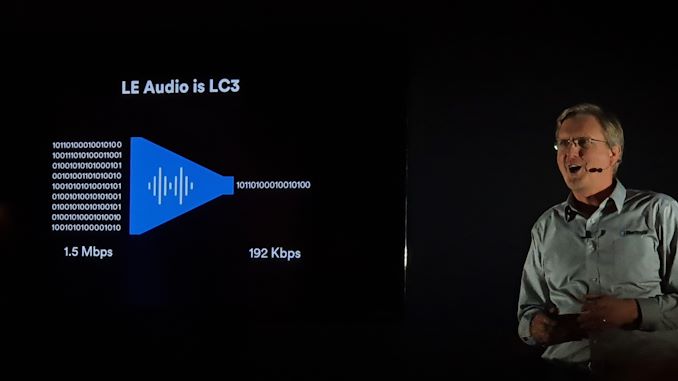
Yesterday the Bluetooth SIG has announced and released the newest Bluetooth standard for audio playback: LE Audio. The new standard is a complete new redesign of the audio stack, building upon the years of learnings that we’ve seen with Bluetooth audio in the past. The new LE Audio standard expends the flexibility and functionality of audio playback over Bluetooth, and is said to represent the new baseline for future developments over the next decade.
Traditional audio playback should be a familiar matter with everybody in the industry as well as consumers. The existing audio stack has now been renamed to “Classic Audio”, and will continue to coexist alongside the new LE Audio standard.
So what does LE Audio bring? The most important aspect of the new standard is self-explanatory and divulged in its very name; it’s based on the new Bluetooth Low Energy radio as opposed to the Bluetooth Classic radio. As a reminder, LE radio is fundamentally different to the classic radio standard and significantly improves upon the power efficiency of transmissions.
LE Audio also brings a lot of new features and helps today’s TWS (True Wireless Stereo) use-cases that we’ve seen over the last few years. TWS audio products nowdays mostly rely on one earpiece receiving the data signal from the transmitter device, and then re-transmits this to its other channel sibling. This is quite inefficient as you might imagine, as you have to transmit from what is usually a very battery limited device. LE Audio now standardises multi-stream transmissions – the source device is the one who handles transmissions of multiple synchronized streams, so for example a smartphone will be able to transmit to both left and right earpieces in TWS products. It is said that the synchronisation here is in the tens of microseconds, allowing for seamless and transparent playback.
There were multiple companies at the launch event showcasing this capability:
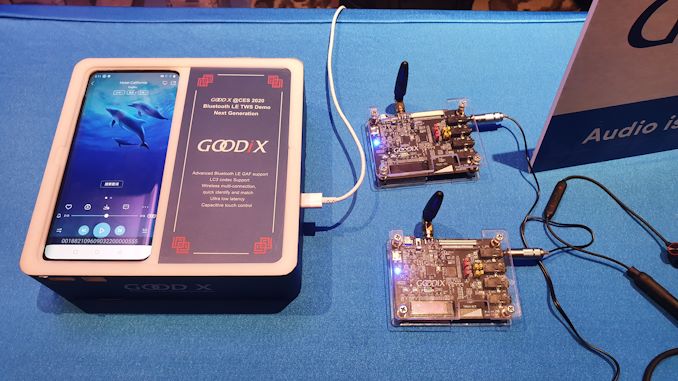
Goodix showcased a production ready development platform with their chipsets, with two of them powering a pair of headphones with flawless synchronisation. Goodix’s demo is Bluetooth 5.1 compliant and supports LE ISOC (isochronous) architecture, which is the official name for this part of the LE Audio standard.
Qualcomm also had a development board showcasing the same feature. Other companies launching LE Audio ISOC solutions were CEVA, Nordic, Dialog and various other vendors.
LE Multi-Stream is envisioned to be able to able to support an unlimited amount of devices when in broadcast mode. Use-cases for this are envisioned to be events and location based broadcasts such as museums or other gatherings, where one would be able to tune into the audio broadcast. It’s to be noted that streams can also be protected as well as public.
Broadcasting also serves as the basis for Audio Sharing, where one can share playback with multiple devices in your immediate surrounding.
The most important aspect of LE Audio is that it brings with it a brand new base audio codec which massively improves upon the aging and lacklustre SBC standard. LE3 (Low complexity communications codec), is actually a quite complex new codec that promises major upgrades in transmission efficiency as well as audio quality.
The most interesting demonstration at the launch event was that of Tim Reilly of T2 Labs. The showcase here was a software demonstration with the ability to seamlessly switch between codecs during audio playback. Tim demonstrated SBC vs LC3 vs no compression, with users being able to hear the difference with the demo headphones.
There were several comparisons to be made. In an equal bitrate scenario at lower absolute bitrates, LC3 was able to blow SBC out of the water in terms of quality. In general, audio quality would only equal out between the two codecs only when SBC had 3x higher bitrate. In essence, LC3 either allows for three times better quality, or three times less energy used when transmitting audio.
The comparison between LC3 and no compression was also very interesting. Although it was quite a noisy environment, I was unable to discern differences in audio playback quality once the LC3 bitrate reached 192kbps. Let’s say that 256kbps would be damn near transparent in terms of quality. 128kbps the differences started to be audible, but still incomparable to how bad SBC sounds at this bitrate.
The LE Audio standard will be released as several standalone specifications for each feature over the course of 2020. What all the features have in common though is that they rely on a new Bluetooth 5.2 core specification, which was publicly released yesterday.
The Bluetooth SIG expects chip manufacturers to be able to release new designs supporting LE Audio over the course of the next year to 18 months, with consumer products (sources and sinks) to closely follow that timeline, with an expected timeline of 18-24 months.
Overall, LE Audio seems to be addressing some of today’s major shortcomings with Bluetooth audio, and most importantly it standardises a new much more capable codec that will hopefully bring some unison to today’s fragmented BT codec landscape. We’re looking forward to the first devices supporting LE Audio and LC3.


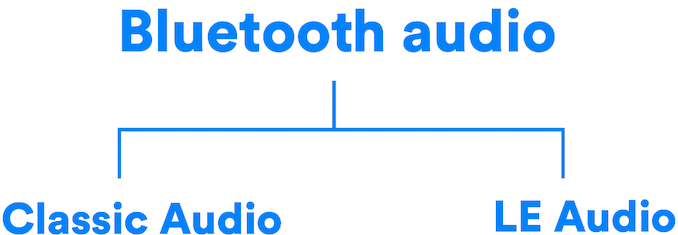
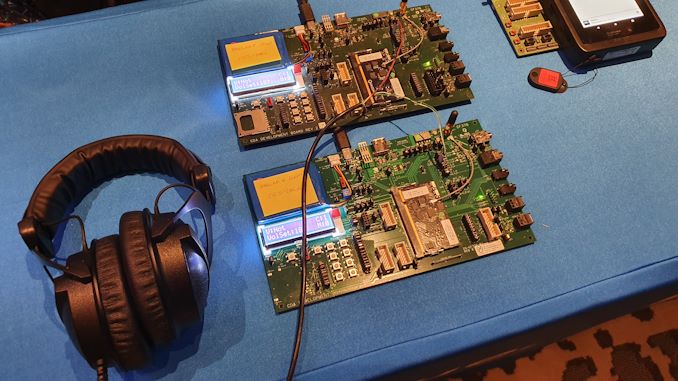
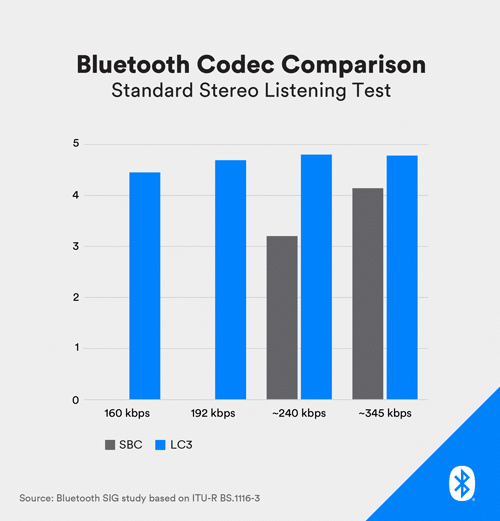








48 Comments
View All Comments
subtec - Tuesday, January 7, 2020 - link
You can use AptX-LL with a PC with a Bluetooth transmitter that supports it.levizx - Wednesday, January 8, 2020 - link
That's the problem, it has to support it in addition to BT standard, while ANY BT 5.2 must support LC3.We can even expect BT 5.1 compliant devices to emerge by the end of the year that supports LC3, and the benefit of those devices is it's future-proof, meaning it can connect to ANY future BT 5.2 devices with LC3. While if you bought into AAC or apt-X ecosystems, there's no such garantee, you still must look for those additional codec.
levizx - Wednesday, January 8, 2020 - link
As far as I can tell, LC3 has an algorithmic delay of 12.5ms, much less than AAC LD's 20-30ms. So the total hardware delay should be around 25-40ms. So under 30ms should be realistic.For comparison, AAC LD can achieve 35-45ms realistically.
This should be good enough for any consumer applications.
ezra7 - Wednesday, January 8, 2020 - link
The largest driving factor causing latency in Bluetooth headphones is the buffer that is used to store 200-300ms of audio in case of intermittent radio interference. The new codec will allow for similar quality audio at a much lower bit rate. A lower bit rate allows for less airtime which means there is less chance for the radio to have interference and more opportunities to recover from dropped audio packets. This will allow for lower latency use cases.faiakes - Tuesday, January 7, 2020 - link
How does it compare to APTX-HD or just regular Aptx?Andrei Frumusanu - Tuesday, January 7, 2020 - link
I wasn't able to compare, but it's 3x better than SBC so you can correlate from there.s.yu - Thursday, January 9, 2020 - link
I don't think it works that way, for example h265 is better than h264, but only at lower bitrates, if we get to the point that film grain is preserved (like proper bluray) h265 has no advantage over h264, so the majority of current bdrips (not the overcompressed stuff that's hardly better than hdtvrip) are still h264.willis936 - Tuesday, January 7, 2020 - link
The "listening test" is indeed the most important empirical tool for evaluating if audio is good enough. However, they don't mention what kind of audio was played back. You can make a sine wave sound good but I don't want to spend money on a wire replacement that makes cymbals, pianos, and snares sound like crap.Andrei Frumusanu - Tuesday, January 7, 2020 - link
I listened to a variety of music tracks. It sounded very good at and after 192kbps.mooninite - Tuesday, January 7, 2020 - link
Why didn't they use Opus? Oh, yeah, so they can license yet another codec. :(There's too many codecs in the world. I'm dreaming of a fantasy world where only AV1, Opus, and FLAC survive inside of Matroska containers.